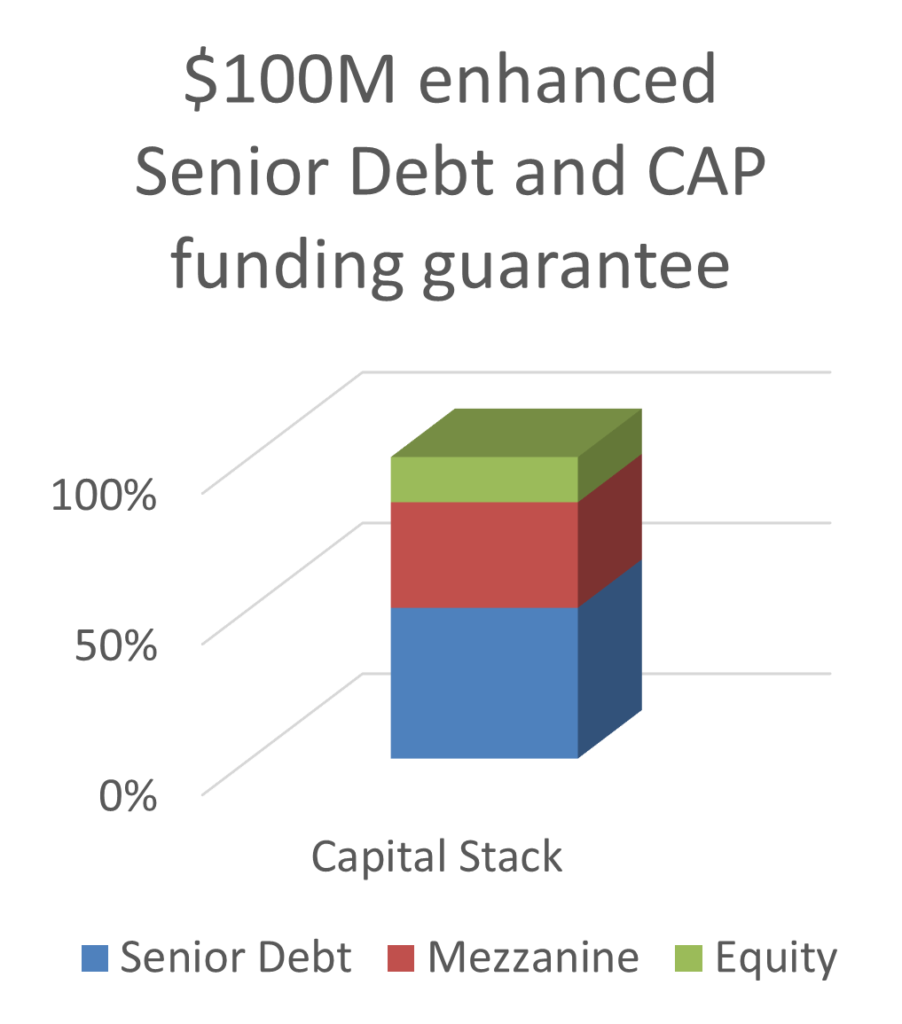What it is
Combining the best of both asset classes — senior debt and mezzanine/equity carried interest — yields better returns at lower risks than debt alone. In3 is a “one stop shop” with a continuum of private funding for impact projects of $50 million or more. 
This structure involves a proportion as senior debt with the rest from our private family office (called CAP funding), which if split 50/50, the capital stack would look like the figure shown on the right. This example uses $100 million total budget, a combination of $50M each, which could be any sector and country where we work.
With $50M as debt, the project would generate the reliable returns of debt service for the lender, whether interest-only or principal plus interest. The remaining $50M via CAP’s family office would combine mezzanine debt and an equity carried interest, in this scenario, potentially leaving ~10-15% of the cashflows for the family office and a similar amount as an equity kicker to the asset owner that brings the completion assurance guarantee. Larger projects can combine multiple guarantees, sharing risks and rewards proportionately.
The guarantee can be securitized via step-in rights to the guarantor — in the unlikely event that the developer does not perform.
How it works

- Complete your normal due diligence process on the project or portfolio (hereinafter, “Project”).
- Once you are comfortable that the project meets your criteria for providing a loan, consider the following:
- Syndicate 30% to 70% of the total loan amount through your normal channels. Put the capital into escrow and use it as collateral to gain a Standby Letter of Credit (SbLC) from a Tier 1 bank.
- With the money in escrow, use it to earn interest against a basket of U.S. Treasuries.
- Now provide the SbLC for an equity interest (to be negotiated) in the Project, noting the anticipated returns expressed as unlevered IRR.
- With this structure you have now reduced your risk and substantially increased your potential returns in comparison to a standard project loan. Why?
- You are putting less capital at risk.
- There will be enhanced contractual rights with the lender and CAP’s family office to cure any potential defaults, and the lender has the incentive to cure because they are the party taking the market risk whereas the guarantor only bears the risk of construction completion.
- Even in the case of a default, not only will the guarantor have earned interest in the meantime, but the guarantor will be entitled to a percentage of any sale of the distressed assets due to their equity position. Even if the assets were to sell at 50% on the dollar, the guarantor would likely still earn approximately what they would have expected to earn under their standard loan program.
- Therefore, when all goes as planned, guarantor earns ~4x your original expected returns, while in the worst-case scenario, you will earn equal to or a little less than expected while at the same time greatly reducing your overall risk profile.
- Depending on how you arrange loans (existing assets from a single source, syndication, etc.), this structure could be used to enhance your total portfolio by contributing a small percentage of money from each loan into the escrow account making your total portfolio of loans safer and more capital efficient.
- In addition, we might be able to arrange an insurance wrapper or bond for the guarantor to hedge their risk even further for a little less equity.
Ask us for CAP funded project examples and additional deal structures




